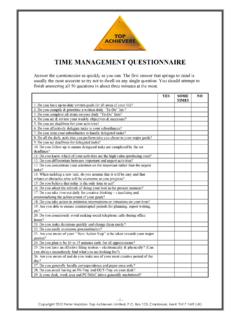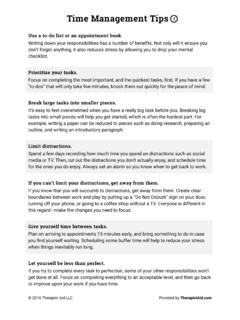Transcription of Goal-Setting and Time Management - Prairielands Council
1 1 Goal-Setting and time Management Goal-Setting and time Management PURPOSE: This course is a requirement for the Venturing Discovery Award; however, it can be taken, at any time , by Venturers whether they are working on the award or not. This course can be presented as a workshop for single or multiple crews or broken into shorter segments and presented at crew meetings or Venturing Forum/Roundtables. The small group approach used in this training can be adjusted to accommodate any number of participants. It is highly suggested that this course be taught by more experienced Venturers as well as adult volunteers participating in the program. OVERVIEW: Finding a successful time Management strategy depends on a person s personality, ability to self-motivate and level of self-discipline. This course introduces established methods for improving a Venturer s ability to effectively manage the events in his or her life in relation to time .
2 LEARNING OBJECTIVES: Venturers will: Increase their awareness of time Management strategies Implement self-selected strategies Predict external time wasters Examine how they spend their time Model how to set priorities Organize tasks by category Assess the importance of using a planning tool Perform work in a timely manner Schedule time appropriately time : Approximately 3 hours. This training can also be divided and presented as individual modules. INSTRUCTIONAL TECHNIQUES: guided discussion, individual and group activities, demonstration, and small group discussion INSTRUCTIONAL MATERIALS: Flipchart and markers Blank paper Pens or pencils Large clear jar Medium-sized rocks (or golf balls) Gravel or pebbles (or marbles) Seeds (or beads) Sample planning tools, , calendars, To Do lists, phone, diaries, work logs, etc.
3 (optional) Separate sheets of 8 1/2 x 11 paper, labeled: ALWAYS, SOMETIMES, RARELY Tape Handouts from appendix Computer, with internet access connected to a projector REFERENCES: Covey, Sean (1998). The 7 Habits of Highly Effective Teens. New York: Touchstone. Covey, Stephen R. (1989). The 7 Habits of Highly Effective People. New York: Free Press. Covey, Stephen R., Merrill, A. Roger, & Merrill, Rebecca R. (1994). First Things First: To Live, to Love, to Learn, to Leave a Legacy. New York: Simon and Schuster. Lakein, Alan (1989). How to Get Control of Your time and Your Life. New York: Signet. Tracy, Brian (2001). Eat That Frog!: 21 Great Ways to Stop Procrastinating and Get More Done in Less time . San Francisco: Berrett-Koehler Publishers, Inc. AGENDA Session time Ice Breaker 10 minutes Course Introduction 5 minutes Tracking Your time 40 minutes Break 10 minutes Setting Priorities 40 minutes Break 10 minutes Getting Organized 40 minutes Break 10 minutes Using Planning Tools 15 minutes Beating Procrastination 15 minutes Scheduling Your time 10 minutes Course Summary 5 minutes Total time 3 hours (210 minutes) ICE BREAKER time ROBBERS (10 min) Materials needed Individual signs labeled: ALWAYS, SOMETIMES, RARELY tape Directions 1.
4 Before the course begins, tape the signs along one wall of the room. 2. Explain that there are many activities we do during the day that fill our time , some of them are productive, others are not. 3. Tell participants that you will name an example of a time Robber an activity that is unproductive. Instruct them to move to the sign that represents how often this time Robber affects them. Realize that participants will be moving with each example you give. Instruct participants to move in an orderly manner. 4. Explain that these are examples of distractions that can cut into the time when they should be doing something else. 5. Have Venturers who get distracted explain how the time Robber affects their ability to get done what they need to do. 6. Close the activity by asking for suggestions on how to better handle time robbers.
5 Examples of time Robbers: (Select a few or all of these items. You may also add additional examples that are not on the list.) Chatting or texting Unexpected visitors Doing tasks that others are capable of and willing to do Doing nothing while standing in line Doing nothing while riding on public transportation or as a passenger in a car Not planning ahead for meals Going to routinely scheduled meetings Checking e-mail when the alert prompts that you have a message Frequenting social networking sites (Facebook, Twitter, Pinterest, Instagram, Google+, Tumblr, etc.) Surfing the Internet Watching TV Hitting the snooze button on the alarm clock to get up at the last minute possible Shuffling toys, food, work, etc. from one table or area to another without putting anything away Not planning your day Running errands without thinking about optimizing your trip time OPTIONAL METHOD OF PRESENTING THE ACTIVITY Divide participants into 5 groups.
6 Assign each group one of the following time wasters: phone/social media; meetings; e-mail; family obligations; and friends/visitors. (If you have fewer than 5 groups; assign more than one time waster to each group.) Have each group formulate solutions to manage their time waster and list them on a flipchart. If participants have internet access, have groups create a word cloud of their suggested solutions. Have each group select a spokesperson to share their list. Guide participants to in the Handbook for Venturers. Have each group evaluate their list of time wasters and assess each to determine which tip might help them effectively manage their time . COURSE INTRODUCTION (5 min) Here s a riddle - You can t save it, you can t borrow it, you can t lend it, you can t leave it, you can t take it with you, you can only do two things with it use it or lose it.
7 What is it? The answer is time ! You only have 24 hours, 1,440 minutes or 86,400 seconds each day. How you use that time depends on skills learned through self-analysis, planning, evaluation, and self-control. What is time Management ? time Management refers to a range of skills, tools, and techniques used to manage events in your life in relation to time . time Management is really a misnomer. We don t really manage time we manage ourselves and our life events in relation to time . We just looked at a few ways we waste our time . Now, we ll explore strategies that can help you more effectively manage events in your life in relation to time . Finding strategies that work best for you depend on your personality, culture, circumstances, and priorities, but you must look critically at yourself and perhaps confront some difficult issues.
8 Guide participants to in the Handbook for Venturers. Tell them that these time Management guidelines will help them as they work through the next activity. TRACKING YOUR time (40 min) Strategy 1 Be time -Aware You cannot manage time well without being aware of how long things take and how you are using your time . Improve your time Management skills by understanding how you use your time . Introduction Have the Venturers calculate how many minutes there are in a year and then, roughly, how many minutes they have been alive. (Answer 525,600 minutes in year which averages out to 7,884,000 minutes for a 15 year-old). Point out that how they use their time is one way they can help themselves reach their personal goals (including Venturing recognition goals !). ACTIVITY Where Does the time Go? Materials Needed: Chart paper and markers Appendix A, How Do I Use My time ?
9 Worksheet Appendix B, Daily time Log Directions Handout Instructions 1. Distribute the How Do I Use My time ? worksheet and explain that they are going to be working independently on all three sections of the worksheet, but will have time to discuss the sections with a partner. 2. Assign partners. 3. Instruct Venturers to complete the following: a. Part I of the worksheet addressing how they spent their time yesterday. b. Part II of the worksheet asking them to rate how well they manage their time in relationship to school, studying, and homework. 4. Stop at this point and collect data from the Venturers concerning Part I and Part II of the worksheet. a. How much time did they spend on the computer, communicating with friends, or watching TV? Have one of the Venturers determine an average. b. How much time did they physically spend with their friends?
10 Have one of the Venturers determine an average. c. Ask the Venturers to turn and talk with a partner (or partners if there are an uneven number of participants) about where they wish they had spent their time when they look back from today s perspective. 5. Next, draw their attention to Part III of the worksheet. Ask the Venturers to work with their partner to determine the following: a. What activity is the most important and how much time should it take up during their day? b. What is next most important activity and how much time should it get? c. And finally, what is the least important activity and how much time will it get? 6. Encourage the Venturers to ask each other questions about their priorities and to expect that their answers may be different. 7. Answer code: Scale for PART II of the time Analysis worksheet a.







